
 Like the Americans and the British, the French regularly scoured the
air corridors linking West Berlin to the "free world" until the fall of the Berlin Wall. The different intelligence aircraft
used in these clandestine reconnaissance flights generically were designated "Gabriel". This is their story.
Like the Americans and the British, the French regularly scoured the
air corridors linking West Berlin to the "free world" until the fall of the Berlin Wall. The different intelligence aircraft
used in these clandestine reconnaissance flights generically were designated "Gabriel". This is their story.
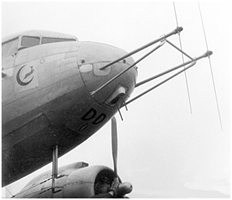 Immediately after the end of the Second World War, the Western powers occupying the western part of Germany took advantage of the air corridors
that allowed them to reach West Berlin by conducting reconnaissance flights in order to gather specific or general information on the Soviet forces
stationed in the eastern part of Germany (1). When we look back at almost 45 years of presence in
the Berlin Air Corridors, we can see that the Americans (> Link)
practiced photographic and electronic reconnaissance, while the British (> Link) seemed to have performed
photographic reconnaissance exclusively. As for the French, they executed mainly - but not only - flights to gather information through the analysis of the
electromagnetic waves emanated by the Warsaw Pact forces.
Immediately after the end of the Second World War, the Western powers occupying the western part of Germany took advantage of the air corridors
that allowed them to reach West Berlin by conducting reconnaissance flights in order to gather specific or general information on the Soviet forces
stationed in the eastern part of Germany (1). When we look back at almost 45 years of presence in
the Berlin Air Corridors, we can see that the Americans (> Link)
practiced photographic and electronic reconnaissance, while the British (> Link) seemed to have performed
photographic reconnaissance exclusively. As for the French, they executed mainly - but not only - flights to gather information through the analysis of the
electromagnetic waves emanated by the Warsaw Pact forces.
The origins
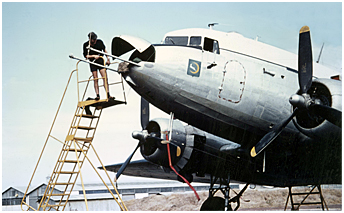
 The early history of French spy flights inside the air corridors remains mysterious. However, it is clear that the main platforms used were Douglas
C-47 aircraft designated "Gabriel" specially equipped to collect electronic intelligence (2).
The onboard equipment was subject to changes, and the modified aircraft saw their name change accordingly: Gabriel I, II, III and IV. Thus, we know
that Gabriel III were used for COMINT missions during the war in Algeria (1954-1962) in 1959 - or perhaps even earlier.
The early history of French spy flights inside the air corridors remains mysterious. However, it is clear that the main platforms used were Douglas
C-47 aircraft designated "Gabriel" specially equipped to collect electronic intelligence (2).
The onboard equipment was subject to changes, and the modified aircraft saw their name change accordingly: Gabriel I, II, III and IV. Thus, we know
that Gabriel III were used for COMINT missions during the war in Algeria (1954-1962) in 1959 - or perhaps even earlier.
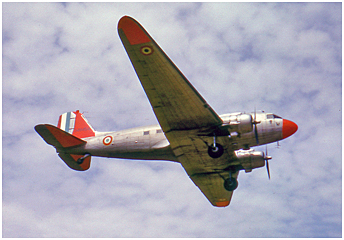 Gabriel IV flew intelligence missions in the Berlin air corridors between December 1957
and the early 1960s (3).
These aircraft were attached to Air Liaison Squadron 55 (Escadrille de Liaison Aérienne - ELA 55) stationed at Lahr-Hugsweier in Germany -
the tactical nuclear strike North American F-100D and F-100F Super Sabres of the Third Fighter Wing also were based on this airbase.
ELA 55 also was assigned the first two N2501 Gabriel V, i.e., n°28 that would have joined the unit
in October 1962, followed by n°42 in mid-1963. The C-47s flew alongside the new N2501 for a few months during a transition period. The last C-47
mission was carried out on May 15, 1963. The aircraft then operated for the benefit of the Electronic Warfare Squadron 30/813 (EGE 30/813).
That unit controlled the action of the Gabriel as well as the monitoring stations on the ground.
On April 1, 1963, Electronics Group 30/450 (GE 30/450) took up residence at Lahr, succeeding EGE 30/813.
Gabriel IV flew intelligence missions in the Berlin air corridors between December 1957
and the early 1960s (3).
These aircraft were attached to Air Liaison Squadron 55 (Escadrille de Liaison Aérienne - ELA 55) stationed at Lahr-Hugsweier in Germany -
the tactical nuclear strike North American F-100D and F-100F Super Sabres of the Third Fighter Wing also were based on this airbase.
ELA 55 also was assigned the first two N2501 Gabriel V, i.e., n°28 that would have joined the unit
in October 1962, followed by n°42 in mid-1963. The C-47s flew alongside the new N2501 for a few months during a transition period. The last C-47
mission was carried out on May 15, 1963. The aircraft then operated for the benefit of the Electronic Warfare Squadron 30/813 (EGE 30/813).
That unit controlled the action of the Gabriel as well as the monitoring stations on the ground.
On April 1, 1963, Electronics Group 30/450 (GE 30/450) took up residence at Lahr, succeeding EGE 30/813.
Gabriel, Comel and la Grise (4)
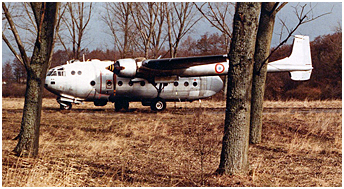
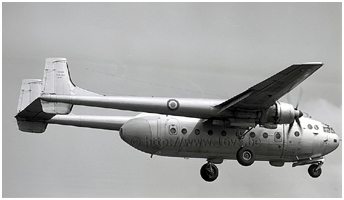 The Nord N2501 Noratlas "Gabriel" epitomizes French reconnaissance flights in the Berlin air corridors to the point that one would think that this role
had never been filled by any other aircraft type. The N2501 Gabriel V aircraft actually were N2501 Noratlas cargo birds converted into spy planes for COMINT
and ELINT missions. While the modification of the first aircraft (n°28) dates back to 1960 as we have seen, the first aircraft did not join ELA 55 at Lahr
before 1962/63 - the first mission would have been flown on October 29 or 31, 1962. In all, eight aircraft were modified: n°25, 28, 33, 36, 39, 41, 42, and 66.
Incidentally, these aircraft were capable of carrying out photographic missions, although they used an unsatisfactory device for this task:
the camera was tied with ropes to the top of the cabin and its operator presumably took the pictures through
the opening of the rear clam shell cargo doors that had a removable part usually removed to drop vehicles.
The Nord N2501 Noratlas "Gabriel" epitomizes French reconnaissance flights in the Berlin air corridors to the point that one would think that this role
had never been filled by any other aircraft type. The N2501 Gabriel V aircraft actually were N2501 Noratlas cargo birds converted into spy planes for COMINT
and ELINT missions. While the modification of the first aircraft (n°28) dates back to 1960 as we have seen, the first aircraft did not join ELA 55 at Lahr
before 1962/63 - the first mission would have been flown on October 29 or 31, 1962. In all, eight aircraft were modified: n°25, 28, 33, 36, 39, 41, 42, and 66.
Incidentally, these aircraft were capable of carrying out photographic missions, although they used an unsatisfactory device for this task:
the camera was tied with ropes to the top of the cabin and its operator presumably took the pictures through
the opening of the rear clam shell cargo doors that had a removable part usually removed to drop vehicles.
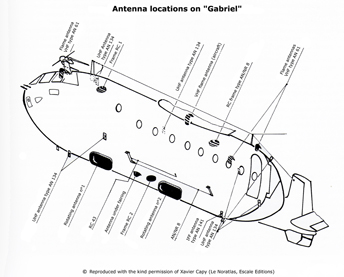
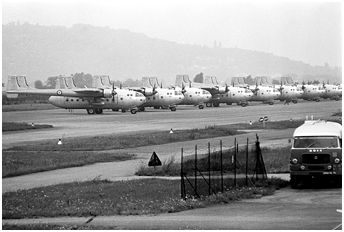 In 1966, the different operators' positions in the rear cabin were occupied as follows:
In 1966, the different operators' positions in the rear cabin were occupied as follows:
- 1/2: two ELINT positions using a AN/ALR8 for detection and localization of radars and analysis of their signals (50-10,750 MHz frequency band)
> the two rotating antennas used for goniometric readings were housed under the two rounded fairings located under the fuselage.
- 3/4/6: three positions for voice intercept operators using VHF receivers in the 30-300 MHz frequency band and tape recorders.
- 5: a receiving station with a AN/NR8 MF radio compass and a recorder.
- 7: a team leader position, responsible for the report summary at the end of the mission.
- 8: one voice intercept operator position using a UHF receiver and recorder.
- 9: an operational traffic analyst.
- 10: a position isolated by a curtain that could be occupied by a coder-decoder (rarely) or a photographer or a passenger.
The latter was sometimes a person from the French Military Liaison Mission (FMLM) provided the opportunity to collect additional information
on selected targets - a number of flying hours had indeed been allocated for this task.
The VHF/UHF voice intercept operators understood Russian, German, Czech or sometimes Polish based to the assigned mission. Communications were recorded
and translated simultaneously. Later, these operators became linguist-analysts. Finally, the "back-end" crew included an engineer in charge of the APU that
was the only source of electricity for onboard equipment. At the beginning, the mechanic was monitoring a Peugeot 403 car engine installed at the rear of
the cargo hold (on the first three aircraft) that functioned as an APU. A Turboméca turbine housed in a fairing located on the right side of the forward
fuselage played this role from 1967-68 on. The electronics were updated or modified over the years. The only piece of equipment that did not undergo significant
change was the AN/ALR8, with the exception of its analytic and recording interfaces that were replaced by the "Smyrne" (Smyrna) system.
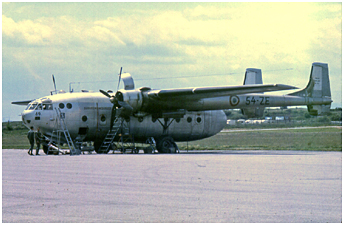
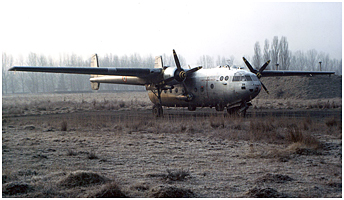 The "front-end" crew was composed of a pilot, a co-pilot, an engineer and two radio-navigators. While the operators in the cargo hold were members of the GE
(Electronic Group), the aircraft crew came from the 54th Electronic Flight (Escadrille Electronique 54 or EE 54 - established on January 1, 1964, still
at Lahr-Hugsweier. The Gabriel aircraft were transferred from ELA 55 to EE 54 and the last mission with ELA 55 took place on January 3). The mission commander was a pilot or a radio-navigator.
The GE and EE 54 naturally had close ties. Until 1970, the EE 54 commander
was also the GE deputy commander. This unit was christened "Dunkirk" in
August of that year. Aircraft and crews reported to the Military Air Transport Command (Commandement du Transport Aérien Militaire - COTAM), but the unit
was available to the 1st Tactical Air Command (1er Commandement Aérien Tactique - 1 CATac) and, from 1965 on, to the new Tactical Air Force
(Force Aérienne Tactique - FATac).
The "front-end" crew was composed of a pilot, a co-pilot, an engineer and two radio-navigators. While the operators in the cargo hold were members of the GE
(Electronic Group), the aircraft crew came from the 54th Electronic Flight (Escadrille Electronique 54 or EE 54 - established on January 1, 1964, still
at Lahr-Hugsweier. The Gabriel aircraft were transferred from ELA 55 to EE 54 and the last mission with ELA 55 took place on January 3). The mission commander was a pilot or a radio-navigator.
The GE and EE 54 naturally had close ties. Until 1970, the EE 54 commander
was also the GE deputy commander. This unit was christened "Dunkirk" in
August of that year. Aircraft and crews reported to the Military Air Transport Command (Commandement du Transport Aérien Militaire - COTAM), but the unit
was available to the 1st Tactical Air Command (1er Commandement Aérien Tactique - 1 CATac) and, from 1965 on, to the new Tactical Air Force
(Force Aérienne Tactique - FATac).
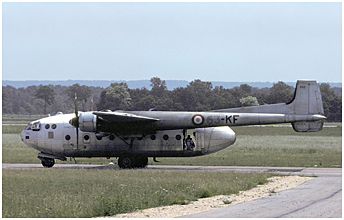
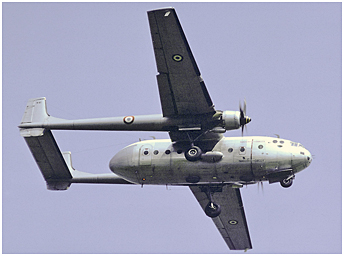 The flight was then equipped with three N2501 Gabriel aircraft: n°28, 39 (dedicated to radars detection and analysis) and 42.
The 1st CATac launched the 1000th Comel - or Communications Electroniques (Electronic Communications) sortie as the missions were designated - flown by N2501 n°28 on January 14
(C-47 and N2501 missions counted together). A Noratlas cargo aircraft (n°49) and a Gabriel (n°66) joined EE 54 in April, while an additional Gabriel (n°36)
arrived in June. It should be noted that some Noratlas cargo aircraft (such as n°83 that also joined the unit) could perform photo missions as well.
A removable cradle with cameras was used for this purpose. Unfortunately, it is difficult to know more, but it seems that a ventral hatch was necessary
in order to use some equipment (see "The SA-10 saga" in the box below).
The only marking on the aircraft was the construction number located on the nose and at the top of the vertical stabilizer
(5). Cargo aircraft sometimes
had a code; however, the only aircraft of the unit that ever received complete markings identifying it as an EE 54 aircraft was Noratlas cargo n°49.
The flight was then equipped with three N2501 Gabriel aircraft: n°28, 39 (dedicated to radars detection and analysis) and 42.
The 1st CATac launched the 1000th Comel - or Communications Electroniques (Electronic Communications) sortie as the missions were designated - flown by N2501 n°28 on January 14
(C-47 and N2501 missions counted together). A Noratlas cargo aircraft (n°49) and a Gabriel (n°66) joined EE 54 in April, while an additional Gabriel (n°36)
arrived in June. It should be noted that some Noratlas cargo aircraft (such as n°83 that also joined the unit) could perform photo missions as well.
A removable cradle with cameras was used for this purpose. Unfortunately, it is difficult to know more, but it seems that a ventral hatch was necessary
in order to use some equipment (see "The SA-10 saga" in the box below).
The only marking on the aircraft was the construction number located on the nose and at the top of the vertical stabilizer
(5). Cargo aircraft sometimes
had a code; however, the only aircraft of the unit that ever received complete markings identifying it as an EE 54 aircraft was Noratlas cargo n°49.

Versatile missions
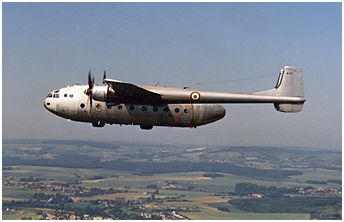 The Electronic Warfare Office (Bureau Guerre Electronique - BGE) of the 1st CATac - later the FATac - planned the intelligence missions based on data
from the Tactical Intelligence Operations Center (Centre d'Exploitation du Renseignement Tactique - CERT).
The BGE sent its orders (date, time, route, targets to cover, etc.) to the joint operations of the Electronic Group and the Electronic Flight.
The main Gabriel missions took place from Metz toward the east (the GE also took part in national or allied exercises and, from the fall of 1969 on,
the missions were extended to the Mediterranean and Africa).
The missions were split into three main variants:
The Electronic Warfare Office (Bureau Guerre Electronique - BGE) of the 1st CATac - later the FATac - planned the intelligence missions based on data
from the Tactical Intelligence Operations Center (Centre d'Exploitation du Renseignement Tactique - CERT).
The BGE sent its orders (date, time, route, targets to cover, etc.) to the joint operations of the Electronic Group and the Electronic Flight.
The main Gabriel missions took place from Metz toward the east (the GE also took part in national or allied exercises and, from the fall of 1969 on,
the missions were extended to the Mediterranean and Africa).
The missions were split into three main variants:
- RE1 along the Inner-German border > Diagram
- RE2 along the Czechoslovakian border > Diagram
- RE3 S, C or N in the Southern, Center and Northern Berlin air corridors, with a stopover at Berlin-Tegel and then return
> Diagram
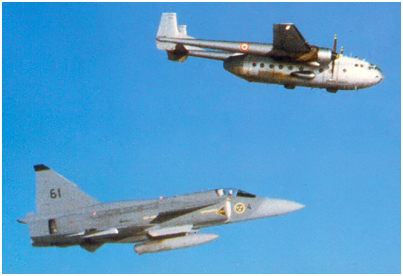 Mission "Baltique !" Les espions en transit au-dessus des eaux internationales faisaient l'objet d'une interception en bonne et due forme
au large de la Suède neutre, quelle que soit leur nationalité. Ce Gabriel est vu ici en compagnie d'un Saab JA37 Viggen de la F7 de Satenas. © Flygvapnet.
Mission "Baltique !" Les espions en transit au-dessus des eaux internationales faisaient l'objet d'une interception en bonne et due forme
au large de la Suède neutre, quelle que soit leur nationalité. Ce Gabriel est vu ici en compagnie d'un Saab JA37 Viggen de la F7 de Satenas. © Flygvapnet.
"Baltic" mission! Spies in transit above the international waters were duly intercepted off neutral Sweden, whatever their
nationality. This Gabriel is seen here alongside a Saab JA37 Viggen of the F7 from Satenas. © Flygvapnet.
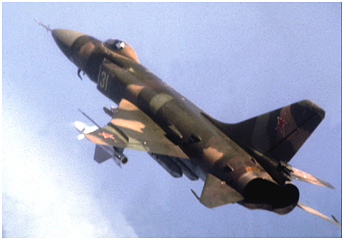 This latter type of mission bore the designation "Baltic" when the aircraft flew through the northern corridor when it left Tegel. The Gabriel headed for
Hamburg at the end of the northern corridor, then proceeded towards Malmö in Sweden prior to heading east over the Baltic Sea.
The Gabriel then flew up to the edges of the Polish and Soviet borders, until ATC announced that it was leaving its airspace. The N2501 returned to Tegel
six hours later. These missions took place only during winter time, because, when the weather was hot, the Noratlas range was insufficient. Such incursions
over international waters, but close to the Swedish and Soviet borders, regularly triggered a reaction by the Swedish air defense forces that sent Draken or
Viggen fighters to intercept the intruder. On the Soviet side, dedicated PVO interceptors such as Su-15s were launched to have a closer look and take
pictures of these intrusive Gabriels.
Flights along the German and Czechoslovak borders at an altitude of 3400-4600 meters (levels 100/150) and a speed of 260 km/h lasted about 6H30.
The aircraft were not pressurized, so oxygen bottles and masks were available to the crew. The N2501 remained outside the Air Defense Identification
Zone (ADIZ) that ran along the borders with the GDR and Czechoslovakia. However, the aircraft were sometimes intercepted by allied fighters as a
consequence of flying near the ADIZ.
This latter type of mission bore the designation "Baltic" when the aircraft flew through the northern corridor when it left Tegel. The Gabriel headed for
Hamburg at the end of the northern corridor, then proceeded towards Malmö in Sweden prior to heading east over the Baltic Sea.
The Gabriel then flew up to the edges of the Polish and Soviet borders, until ATC announced that it was leaving its airspace. The N2501 returned to Tegel
six hours later. These missions took place only during winter time, because, when the weather was hot, the Noratlas range was insufficient. Such incursions
over international waters, but close to the Swedish and Soviet borders, regularly triggered a reaction by the Swedish air defense forces that sent Draken or
Viggen fighters to intercept the intruder. On the Soviet side, dedicated PVO interceptors such as Su-15s were launched to have a closer look and take
pictures of these intrusive Gabriels.
Flights along the German and Czechoslovak borders at an altitude of 3400-4600 meters (levels 100/150) and a speed of 260 km/h lasted about 6H30.
The aircraft were not pressurized, so oxygen bottles and masks were available to the crew. The N2501 remained outside the Air Defense Identification
Zone (ADIZ) that ran along the borders with the GDR and Czechoslovakia. However, the aircraft were sometimes intercepted by allied fighters as a
consequence of flying near the ADIZ.
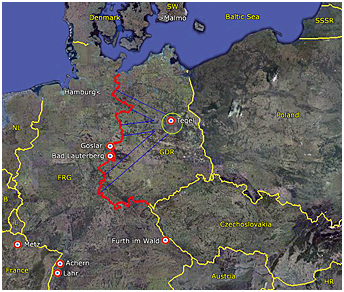
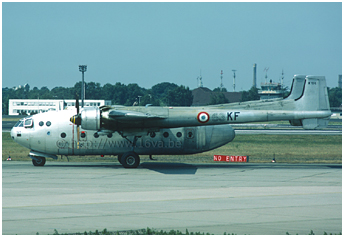 Before the first Gabriel aircraft were equipped with an APU turbine, flight duration was longer, between 7 and 7H30. The interception of messages from Soviet
or national aircraft flying on the other side of the border indicated that the Gabriel had been identified.
Before the first Gabriel aircraft were equipped with an APU turbine, flight duration was longer, between 7 and 7H30. The interception of messages from Soviet
or national aircraft flying on the other side of the border indicated that the Gabriel had been identified.
Inside the Berlin air corridors - the crew members
took a parachute for these missions - flights took place at an altitude close to the maximum-allowed 3000 meters, that is to say, flight levels 80 or 90
(2450 - 2750 meters), or much lower when the tasking was to take pictures. The N2501 was assigned fake radio call signs selected from a list provided by
the COTAM. These call signs were changed for each mission. Comfort aboard was almost nonexistent: operators achieved success intercepting and translating
enemy radio communications despite the engine noise, the permanent whistling of the turbine and turbulence. Navigation, of paramount importance in the
corridors, depended mainly on the quality of the radio-navigators, while the pilots flew the aircraft manually most of the time. During their penetration
into the GDR, the electronic equipment of the Gabriel platform could cover the entire territory and even a little beyond the GDR-Polish border.
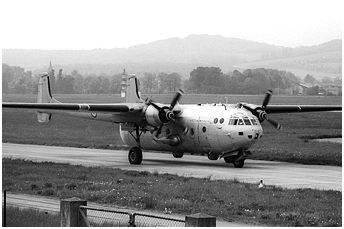
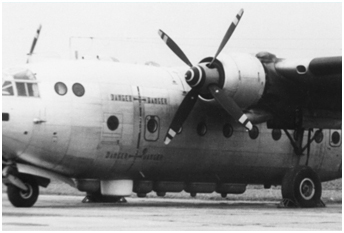 The planes were tracked by the air defense radars - Soviet radar operators called the Gabriel the "crawfish". Of course, the Soviets knew the difference between
a standard Noratlas and a Gabriel. Fighters were sometimes sent for visual identification. They positioned themselves under the Gabriel to check the presence of
the two ventral radomes and announced on the radio "it's a male!" The Gabriel also represented a target of choice to train fighter pilots and SAM battery operators!
In doing so, these actions constituted a good source of information for the French crews... Gabriel navigators were sometimes subjected to "meaconing" attempts.
That consisted of reemitting the radio beacon emissions on the same frequency to disrupt navigation and, in such circumstances, the Gabriel could have drifted
outside the corridors. However, the onboard operators were able with a few minutes delay to determine the Gabriel's position as it was seen on the PVO radar
scopes, because they intercepted the signals the radar sites sent to their command center. But, what would have happened if a Gabriel had been forced to land
in the GDR? There were only verbal instructions: tear all documents and maps into small pieces and then throw them out through the opening of the marker flare
ejector (a process that would have been very time consuming?), eat the code and, once landed, the last to leave the plane had to open gas draining taps inside
the fuselage and discharge an emergency flare to set fire to the aircraft... Missions were generally carried out during daytime, but the routine would change
during Warsaw Pact exercises, unusual activity or in time of crisis. As an example, a Gabriel that had departed Metz between 9 and 10 o'clock landed at Tegel
usually around 15-16H00 and its crew spent the night there. The mission reports were then sent to Metz via the local ground monitoring station. But, timetables
could obviously vary based upon the missions and contingencies and the plane might even go back to Metz on the same day.
The planes were tracked by the air defense radars - Soviet radar operators called the Gabriel the "crawfish". Of course, the Soviets knew the difference between
a standard Noratlas and a Gabriel. Fighters were sometimes sent for visual identification. They positioned themselves under the Gabriel to check the presence of
the two ventral radomes and announced on the radio "it's a male!" The Gabriel also represented a target of choice to train fighter pilots and SAM battery operators!
In doing so, these actions constituted a good source of information for the French crews... Gabriel navigators were sometimes subjected to "meaconing" attempts.
That consisted of reemitting the radio beacon emissions on the same frequency to disrupt navigation and, in such circumstances, the Gabriel could have drifted
outside the corridors. However, the onboard operators were able with a few minutes delay to determine the Gabriel's position as it was seen on the PVO radar
scopes, because they intercepted the signals the radar sites sent to their command center. But, what would have happened if a Gabriel had been forced to land
in the GDR? There were only verbal instructions: tear all documents and maps into small pieces and then throw them out through the opening of the marker flare
ejector (a process that would have been very time consuming?), eat the code and, once landed, the last to leave the plane had to open gas draining taps inside
the fuselage and discharge an emergency flare to set fire to the aircraft... Missions were generally carried out during daytime, but the routine would change
during Warsaw Pact exercises, unusual activity or in time of crisis. As an example, a Gabriel that had departed Metz between 9 and 10 o'clock landed at Tegel
usually around 15-16H00 and its crew spent the night there. The mission reports were then sent to Metz via the local ground monitoring station. But, timetables
could obviously vary based upon the missions and contingencies and the plane might even go back to Metz on the same day.
The SA-10 saga In 1977, signals on new frequencies were intercepted during a mission inside the Berlin corridors. Emissions were rare and stopped as soon as the plane approached. It was thought that these signals emanated from the new SA-10 (S-300) SAM system. A trap was organized to gather more information about this target of choice. For this purpose, a mission was prepared involving two N2501, a Noratlas cargo and a Gabriel. The cargo aircraft that was equipped for photography would fly though the central corridor where the new SAM system had been spotted, presumably in the Letzlinger Heide training area north of Magdeburg. The Gabriel would fly through the northern corridor and monitor the airwaves. Upon entering that corridor, the Gabriel already notified the Noratlas cargo aircraft that it was receiving the suspicious emissions. The 75mm Omera 40 panoramic camera and the trimetrogon (probably composed of three 600mm Omera 36 cameras, one vertical and two in oblique position for horizon-to-horizon photography) were triggered for the overflight of the training range, but the emissions ceased when the Noratlas was over the target. However, photographs revealed the radar vehicle, with the added bonus of the antenna retraction sequence and a 3D view that provided verification of the frequencies used. It was the first aerial photography of this type of equipment that generally only operated under cloud cover to escape the curiosity of the American satellites. From C. Fontaine in "Les avions de Renseignement Electronique" |
notes
SIGINT : SIGnal INTelligence. Encompass COMINT and ELINT
COMINT : COMmunication INTelligence or intelligence on voice communications
ELINT : ELectronic INTelligence or intelligence on electronic signals
(1) Intelligence activities later also concerned the East German National People's Army (NVA) that was officially established
on January 18, 1956.
(2) Gabriel is the patron saint of signal personnel.
The name could also mean "Groupement Aérien de BRouillage et d'Interception Electronique" (Jamming and Electronic Interception Air Group).
Another interpretation would be "Groupement Aérien de Bouillage de Recherche et d'Identification ELectronique."
(3) Aircraft identified:
C-47B 43-49454 (Dakota IV KK134) - c/n 15270/26715 - F-UJGN - 01-1958 / 12-1965
C-47B 44-76721 (Dakota IV KN515) - c/n 16305/33053 - F-UJGG - 12-1957 / 09-1963
This aircraft was modified as a "Turbo" DC-3 (Basler 67) by Basler in November 1989.
The first mission would have been flown on March 3, 1958 according to Xavier Capy.
(4)
The Gabriel V was simply designated "Gabriel" or "Comel" for Communications Electroniques.
"La Grise" (the Gray) was also the nickname of any
version of the Noratlas.
(5)
N°25 that was delivered to the firemen at Tegel had the code "VM". When was it applied?
N°28 has been photographed with the EE 54 unit badge on
the nose. N°66 had the EE 1/54 emblem on the nose when it made the last flight of a French AF N2501 on October 26, 1989.
That aircraft had
temporarily received the ETOM 88 badge in 1976 after a deployment to Djibouti.
| Jamming the Foxbat |
 |
Gabriel over Germany > Part 2 |
 |
Plan du site - Sitemap |  |
